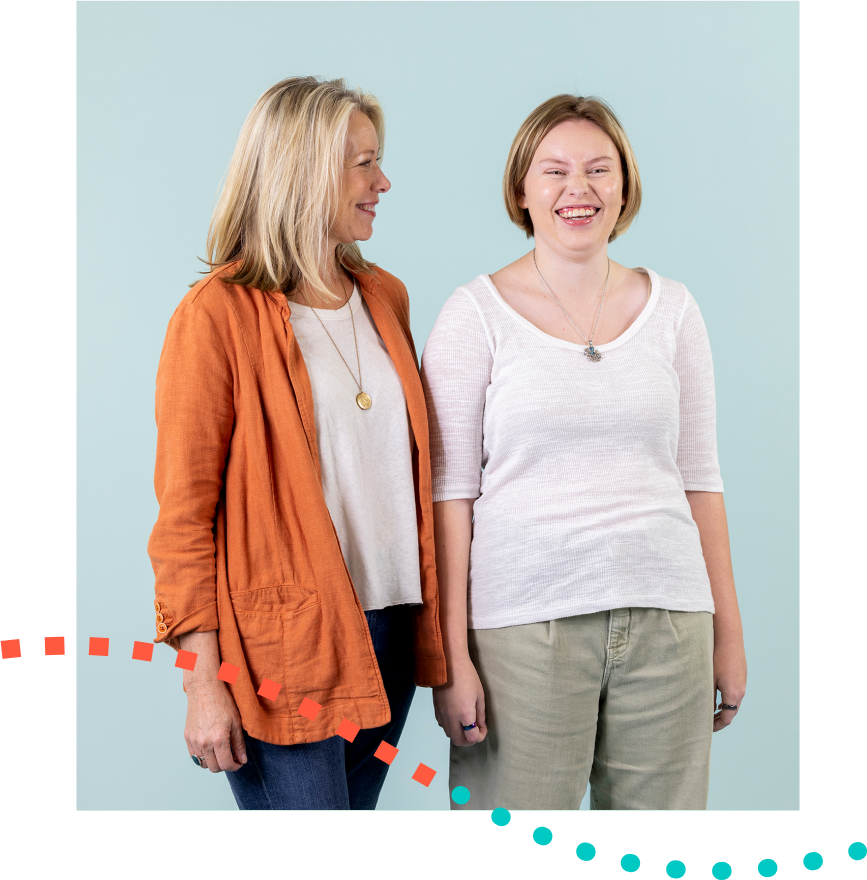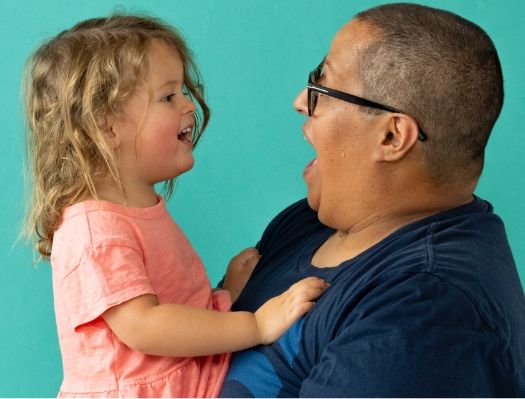Understanding Autism
The Autism Experience
What is Autism?
Autism, or Autism Spectrum Disorder (ASD), is a lifelong developmental condition that is usually identified in early childhood. As a “spectrum,” it looks different for everyone but can affect how a person communicates, interacts socially, builds relationships, and manages emotions to varying degrees.
Although we don’t know the exact cause of Autism, getting a diagnosis early can help individuals and families access resources and support that promote a fulfilling life.


Autism can be an Invisible Disability
Autism is sometimes an invisible disability, meaning you can't always see it. Invisible, or hidden, disabilities are conditions that can affect how a person moves, senses the world, learns, or works. These challenges aren’t always obvious to others.
Because Autism may not be noticeable, people might not get the support they need to thrive in community settings. Understanding your needs and the right kind of support is important for being able to participate fully in the community.
At the Autism Society of NEPA, we work to raise awareness about Autism as an invisible disability and to celebrate neurodiversity. Our goal is to create a community where everyone, regardless of visible or hidden challenges, feels supported and included.


Signs & Characteristics
Autism, or Autism Spectrum Disorder (ASD), affects each person differently, and the signs can vary widely. Some common characteristics include differences in communication, social interaction, and behavior.
Here are some signs that may be present in autistic individuals:
Communication differences: Some people with Autism may speak less or communicate in different ways, such as using gestures, pictures, or devices. Others may speak fluently but struggle with back-and-forth conversations.
Social interaction differences: Autistic people may have a hard time understanding social cues, like facial expressions or body language. They might prefer to be alone, or they may want to connect but find it difficult to do so in typical ways.
Repetitive behaviors: Repeating certain actions, movements, or sounds (like hand-flapping, rocking, or repeating phrases) is common. Autistic individuals may also develop strong routines or specific interests.
Sensory differences: Many autistic people are more or less sensitive to things like lights, sounds, textures, or smells. They might feel overwhelmed in busy places or uncomfortable with certain sensations.
Difficulty with changes: Unexpected changes in routine can be hard for autistic people. Predictability and structure can help them feel more comfortable and secure.
It’s important to remember that Autism is a spectrum, which means every autistic person is unique. Some may need a lot of support, while others may need less.
If you recognize these characteristics in yourself or someone else, seeking an evaluation can be a helpful step toward understanding and accessing support.
Prevalence
Autism is found all over the world, but how often it’s identified can differ depending on how it is reported. In 2023, the Centers for Disease Control and Prevention (CDC) shared its latest report on Autism prevalence in the U.S.
The report showed that Autism is now diagnosed in about 1 in every 36 children, which is more than three times the rate reported in 2004, when it was 1 in 125.
Children diagnosed with Autism by age 4 are much more likely to receive the services and support they need early in life.
The 2023 report noted that more White and Black children are being diagnosed with Autism than Hispanic children.
Studies show that children of color, including Hispanic children, may still get diagnosed later than White children. Barriers such as stigma, limited access to healthcare, immigration status, income level, and language differences can delay early identification.
Boys are about four times more likely than girls to be diagnosed with Autism. However, new research suggests that Autism may look different in girls, meaning they might be less likely to get a diagnosis due to these differences in how they show signs of Autism.
It's important to recognize that Autism affects people of all races, genders, and backgrounds, but access to diagnosis and support services can vary. Addressing these barriers is critical to ensuring that everyone receives the care and resources they need.
What Causes Autism?
There is no single known cause of Autism, but it is widely understood that it relates to differences in brain development. Brain scans show that the shape and structure of the brain in autistic individuals can be different from those in people with typical development.
Researchers are still exploring the exact cause of Autism and are looking at several factors, including genetics and health conditions. In many families, Autism or related conditions seem to run in the family, which suggests a genetic link. Autism may also occur more frequently in individuals with certain medical conditions like fragile X syndrome (FXS), tuberous sclerosis, congenital rubella syndrome (CRS), or untreated phenylketonuria (PKU). Exposure to harmful substances during pregnancy has also been associated with a higher likelihood of Autism.
While no single gene has been found to cause Autism, researchers are studying patterns in genetic code that might be linked to it. Some people may be born with a genetic tendency to develop Autism, but there is no single "trigger" that causes it. Other researchers are studying whether certain conditions during pregnancy or childbirth, such as viral infections or exposure to harmful substances, could play a role in the development of Autism. Environmental factors like chemical exposure or complications during pregnancy are also being investigated.
While there has been misinformation in the past, we know that Autism is not caused by vaccines, parenting style, or nutrition.
Diagnosis & Screenings
Autism is usually diagnosed by observing a person’s behavior and development. Doctors, psychologists, and other specialists look for signs of Autism through screening tools, interviews, and assessments. These signs often show up in early childhood, but some people may not be diagnosed until later in life, especially if their Autism is less noticeable.
Parents, caregivers, or teachers might notice that a child is not meeting developmental milestones, such as talking, playing, or interacting with others. When this happens, they can ask a healthcare provider for a developmental screening. This screening checks for early signs of Autism and other developmental differences.
If the screening suggests that Autism may be present, a more detailed evaluation is done by specialists. This can include a combination of interviews, observation, and testing. The specialists will look at social communication, behavior, sensory processing, and other areas that may be affected by Autism.
The signs and support needs can be different for each person. Early diagnosis can help people access the support and services they need to thrive at home, in school, and in the community.
To learn more about receiving an Autism diagnosis, visit our Screening & Diagnosis page.
Related & Co-Occurring Conditions
Medical studies show that about 47% of adults and 45% of children with Autism experience gastrointestinal (GI) issues. The most common symptoms are diarrhea, followed by stomach pain and constipation. For people with Autism, constipation often means slow movement of stool with long gaps between bowel movements. When a bowel movement does happen, it may be loose rather than hard or impacted.
Many autistic people may also experience issues with their immune and gastrointestinal (GI) systems. This means they might be more likely to have frequent illnesses, allergies, or sensitivities, as well as stomach problems like diarrhea, constipation, or stomach pain.
These challenges are common and can affect a person’s overall well-being. If you notice these symptoms, it’s important to talk to a healthcare provider to help manage and treat them effectively.
Some autistic people may also have an intellectual disability, which means they might need extra support in learning, problem-solving, and daily life skills. Intellectual disability affects thinking and understanding, and this can vary from person to person.
It’s important to use the right tools when assessing intellectual ability. Unfortunately, some research studies have used inappropriate IQ tests, like verbal tests for people who don’t use verbal communication. In some cases, intelligence levels have been estimated without proper evidence. To get a more accurate understanding, tests that don’t rely on language, such as the Test of Nonverbal Intelligence (TONI), are better suited for individuals who have limited or no verbal skills.
With the right support and accurate assessments, autistic individuals with intellectual disabilities can learn, grow, and thrive.
About 30% to 50% of children with Autism have moderate to severe low muscle tone. This means their muscles may feel weaker or less firm than expected. Low muscle tone can affect both gross motor skills, like running or jumping, and fine motor skills, like writing or using small objects. Low muscle tone may also lead to problems with posture, balance, and endurance, which can make everyday activities, like sitting up straight or staying active for long periods, more tiring.
With the right therapies and support, children with low muscle tone can improve their motor skills and build strength over time.
Pain tolerance can vary widely in autistic people. Some may have a very high pain threshold, meaning they might not feel pain as easily, while others may have a very low pain threshold and feel pain more intensely. These differences in how pain is experienced are related to how the brain processes sensory information.
There are interventions, like sensory integration therapy, that can help improve how the brain processes and responds to sensory information. This can make pain responses more reliable and help individuals feel more comfortable in their environment.
Pica is a condition where a person eats non-food items like dirt, paint, paper, or sand. This behavior can be dangerous, leading to choking, digestive issues, infections, or other health problems. About 23% of autistic children experience pica, and it’s even more common in autistic individuals who also have an intellectual disability, with rates as high as 28% in some studies.
If pica is a concern, it’s important to work with healthcare providers to manage the condition and ensure safety. Behavioral interventions, environmental modifications, and nutritional support can help reduce the risks associated with pica.
Seizures are common in individuals with Autism Spectrum Disorder (ASD). Research shows that between 20% to 40% of autistic people also experience epilepsy, a condition that causes recurrent seizures. The risk of having seizures is higher in individuals with co-occurring intellectual disability or other neurological conditions.
Seizures can vary in type and severity, ranging from mild staring spells to more severe convulsions. These seizures may occur at any age, but most often start after age 10. An electroencephalogram (EEG) is often used to diagnose seizure activity.
Early identification and proper management of seizures are important, as untreated epilepsy can negatively impact cognitive and behavioral development. Medications and therapies can help control seizures and improve quality of life.
Many autistic individuals also experience Sensory Processing Disorder (SPD), which affects how they respond to sensory input like sound, touch, or light. People with SPD may be hypersensitive (overly responsive) or hyposensitive (under-responsive) to different sensory experiences. For example, some may avoid loud noises, while others may seek out intense sensory input like deep pressure.
Research suggests that up to 90% of autistic individuals show signs of sensory processing challenges. Recognizing these differences is important for creating supportive environments that meet their needs.
Many autistic individuals experience sleep challenges. Research shows that 40% to 80% of autistic children struggle with sleep issues like difficulty falling asleep, night waking, or waking too early. Causes of night waking may include gastrointestinal issues, allergies, environmental sensitivities, seizures, or the effects of medications. Sleep apnea, sleep terrors, and sensory processing difficulties can also contribute to these problems, making it harder to fall asleep and increasing nighttime awakenings.
Addressing these issues through routines, environmental changes, and medical support can help improve sleep.
Around 12.1% of autistic children experience some level of vision impairment, and 2.9% have hearing difficulties, while children with hearing or visual impairments are more likely to also have Autism. About 30% of children who are deaf or blind are diagnosed with Autism. Sensory impairments can sometimes mask Autism-related behaviors, such as social interaction challenges, making diagnosis more difficult. For example, a child born deaf may seem unresponsive, delaying an Autism diagnosis.
Early screening for hearing and vision is essential to provide the right support. Tailored education and therapy can help children with these dual diagnoses thrive.

